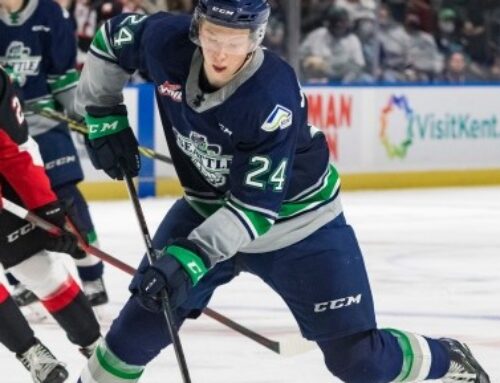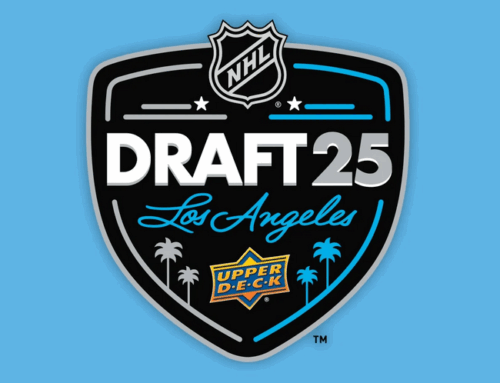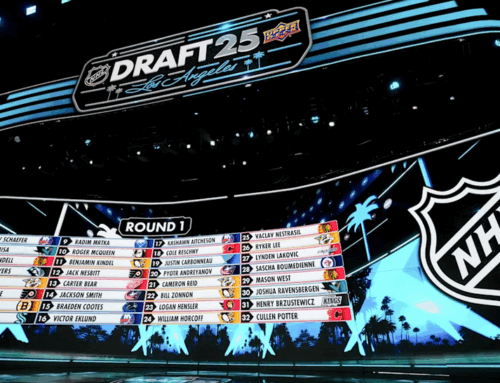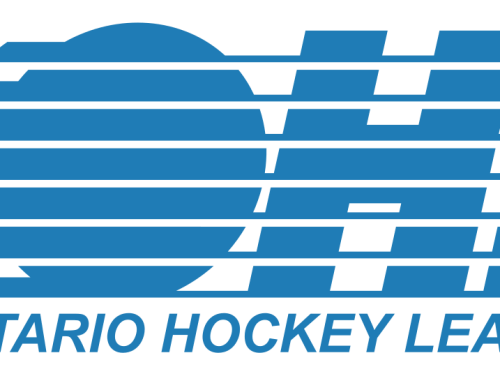Prospect Ramblings: What FC Barcelona Taught Me About Scouting, Coaching/Tactics and Player Development
Hadi Kalakeche
2022-02-15
Welcome to my ramblings, where I’ll be writing down my thoughts on NHL and draft-eligible prospects once a week. I’ll be using the ramblings to keep you posted on the week’s events, or let you in on some questions I ask myself often regarding prospects, amateur scouting and player development.
I’ve been wanting to sit down and write about this subject for quite some time. Growing up, I split my time evenly between living in Lebanon and in Quebec, and our extended family have been fans of FC Barcelona for longer than I’ve been alive. One of my first memories as a child was sitting in front of a small, grainy TV and watching 17-year-old Lionel Messi score his first professional goal, off a brilliant lob pass from Ronaldinho.
Then, when going to Lebanon every summer and winter wasn’t as financially viable anymore and my family settled permanently in Canada, I discovered hockey. It was in 2007-2008; I was scrolling through channels trying to find something to watch and stumbled upon a Habs-Red Wings game, and the moment I landed on that channel, Pavel Datsyuk got the puck, dangled through the entire Habs defense and just barely got stopped by (I think) Cristobal Huet.
It was love at first sight. I had found my Lionel Messi, the player who would shape the way I watch, think and play the game moving forward. Somehow, like a true masochist, I ended up cheering for the local team which got their rear handed to them by the Wings, but that was the moment that led me down the path I am on today, writing these lines.
Enough backstory, though. I want to share with you the core principles I carry over from my time watching the glory days of FC Barcelona, while also showing the core differences between soccer and hockey. The influences on the way I scout and watch the game are threefold: first we’ll discuss what I look for in elite prospects, then we’ll talk about coaching and hockey tactics, and finally I’ll mention the player development elements which are at the core of my hockey philosophy.
Scouting: Lionel Messi, Pavel Datsyuk, Connor Bedard — Control the Chaos, Control the Game
When I watched Lionel Messi dribble for the first time, it truly seemed like he could see everything slowly, even at full speed, and would never be able to lose the ball. When I watched Pavel Datsyuk dangle for the first time, I had that same impression. The small ways in which they both managed to use their entire bodies to shield, cut, fake and wiggle their way through defenders, shaped the way I scout prospects to this day.
Control the chaos, and you control the game.
I could watch old Pavel Datsyuk highlights all day long. What an incredible player. The laugh in the first clip is very fitting because this entire reel is hilarious pic.twitter.com/I7RGIH7yeM
— Dimitri Filipovic (@DimFilipovic) May 12, 2020
Especially in a sport as high-paced and chaotic as hockey, being able to read opponents and defensive formations quickly, and select the right play at the right time to free up even a second or an inch of time and space, is the difference between the great and the legendary.
Connor Bedard gives me those vibes.
The way he manipulates and exploits his opponents’ ankles, the way he reads plays at full-speed and reacts appropriately depending on what’s ahead of him, and the way he can be a threat from any distance, make him a truly exceptional forward.
There are prospects available this year that show glimpses of what makes Messi, Datsyuk and Bedard so special, despite having areas of weakness. One that comes to mind is Frank Nazar. The amount of times that he seemed cornered and dispossessed from the puck, and I’d look down at my data sheet to mark him down for a turnover only to look up and see him still carrying the puck, really made him a no-brainer in my top-five. His ability to control the chaos, in my mind, is second-to-none in this draft class.
Frank Nazar is so damn cool. #2022NHLDraft pic.twitter.com/RiugfCJ4XF
— J.D. Burke (@JDylanBurke) January 20, 2022
As he goes up a few levels and encounters even more chaos and pressure, Nazar’s creativity, resilience and intelligence could shine even brighter. We’ll talk about it some more in the player development section coming up later on, but these are core elements that I value greatly when watching prospects and would build a team around if placed in a position to do so. That likely comes from a decade and a half of watching the best soccer player in history do those things on a regular basis and make them seem effortless.
Coaching/Tactics: Greater Than the Sum of its Parts
My interest in the tactical elements of the team sports I watch only really started once I began watching hockey, but that was a simple matter of coincidence. 2008 was also the year that legendary coach Pep Guardiola took the helm of FC Barcelona, turning a team of great individuals into a multi-cellular organism, engineered perfectly to score goals and win games.
Seeing that team gradually become unstoppable, winning six titles in 2009 alone, made me realize that there’s an entire side to the game of hockey that I had yet to tap into. I began paying attention to OZ, NZ and DZ formations, the different ways teams used to either shut things down entirely, or open up the ice. One thing that stood out to me is how structured NHL offensive tactics are when compared to Pep’s free-flow game in the final third.
🗣| Pep Guardiola:
“My job is taking you to the final 3rd and your job is to finish.” #PepQuotes pic.twitter.com/1MOQn8rnE7
— City Chief (@City_Chief) February 2, 2020
The Toronto Maple Leafs’ application of defensive overlaps and forwards coming back high into the OZ to balance out the formation is the closest I’ve seen so far to that principle, and even that is still a good distance away. Structured and active in the first two zones, the Leafs quickly start flowing like water when they reach the final third. D’s pinch, F1 circles up, F2 and F3 create wide options and one-two opportunities with the overlapping D’s, all while shooting and retrieving, shooting and retrieving.
Two noteworthy elements:
With under 1 minute left in P1 and immediately following a PK, TOR goes with a superline of 91-34-88
34 playing very high in OZ allows both Ds (38/78) to attack downhill and land at the net for scoring chances. pic.twitter.com/4sCyK2KTwB
— Jack Han (@JhanHky) February 13, 2022
This shot-retrieval concept is the main separating factor between hockey and soccer, as the latter’s offensive principles, by virtue of the slower pace of play, larger playing surface and quantity of players, make it necessary to try to create the best chance possible, and capitalize on it. There aren’t 60 shot attempts per side each game; a soccer team considered aggressive offensively will usually put up 20 attempts at most.
However, the core principle of allowing freedom within your structure, especially offensively, allowing your players to use their minds rather than be boxed into what the system dictates they should do, is something that I think applies wonderfully to both sports. The Habs’ new head coach, Martin St-Louis, touched on that briefly when asked about his coaching philosophy a couple of days ago.
I've always thought this, and maybe I carry this mindset over from my time watching the glory days of FC Barcelona:
Your system should be the blueprint, not the finished building. Freedom and creativity, when your players are smart and synergistic, is a beautiful thing. https://t.co/rkUkLSEs6y
— Hadi K. Scouting (@HadiK_Scouting) February 10, 2022
Building your team around concepts rather than systems — whether that’s possession and creativity like Pep’s Barcelona, hermetic defense and counter-attack like Mourinho’s Real Madrid, gegenpressing like Klopp’s Liverpool, shutting down the NZ like Lemaire’s Devils or defensive activation like Keefe’s Leafs — is the way forward in order to build success. The latter team still has to shake its demons, but they’re on the right track, and that’s a good start.
Player Development: Baking Your Philosophy Into Your Pipeline
I’ll start by mentioning that the way player development works in European soccer vs. the NHL is truly apples to oranges. The former can sign seven-year-olds to their academies, like La Masia for FC Barcelona, and teach them from a young age what the club values from its players, and the way they want them to play. The latter only obtains players’ rights through the draft, when they’re 17 to 21 years of age and have already gone through eight different teams, with eight different systems and eight different philosophies (for the most part).
However, all that needs to happen in hockey to recreate a structure similar to La Masia is for teams to hone in on exactly which core elements of a prospect’s game they value within their organization, and draft/trade for that. If it’s hockey sense, or character, or physicality, or whichever concept works for them, being selective with which qualities they want universally within their pipeline and drafting for said qualities is the closest an NHL team can get to having every prospect in the system understand the team’s philosophy.
Josep "Pep" Guardiola Sala, Mikel Arteta Amatriain and Xavier Hernández Creus were all fantastic Spanish controllers who graduated from La Masia. Recently, they have all gone on to become elite-level managers.
"Controllers" have the best understanding of the beautiful game. pic.twitter.com/8LzMqDCs4X
— EBL (@EBL2017) February 12, 2022
If a team is like the Habs, where they rely on most, if not all of their forwards to be responsible defensively, drafting a prospect who isn’t that guy and trying to make him that guy, is a waste of resources. Of course, a problem arises when new blood takes over the team and the coveted philosophy changes, but with the way teams change drastically from year to year, especially when things go bad, the adjustment in the NHL is much more swift.
Rather than waiting as long as 10 years at times to see philosophical changes within the structure, it’s a matter of 3-5 years, from the moment new management starts making draft picks and trades to the moment those draft picks or trade assets join the organization and adapt to its core principles (see the Leafs pre-2016 vs. post-2016 for reference).
Maybe it’s wishful thinking, but I think hockey has so much more room to grow, tactically and philosophically. There’s a lot of avenues that either haven’t been explored, or been explored imperfectly, to the point that good ideas might have been thrown out prematurely. Could a possession game work in the NHL, if the right structural balance is found? Could the NZ trap be revamped in a way that works against modern attacking principles?
Whatever changes the next 50 years will bring in hockey, I’m along for the ride, and will be studying them closely.
Thanks for reading — follow me on Twitter @HadiK_Scouting for all of your prospect-related needs!






